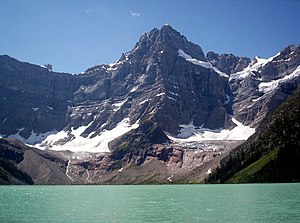Howse Peak
| Howse Peak | ||
|---|---|---|
|
Howse Peak with Lake Chephren from the northeast |
||
| height | 3295 m | |
| location | Alberta / British Columbia , Canada | |
| Mountains | Canadian Rockies | |
| Coordinates | 51 ° 48 '50 " N , 116 ° 40' 52" W | |
|
|
||
| First ascent | 1902 by John Norman Collie , Hugh EM Stutfield, George M. Weed and Herman Woolley under the leadership of the Swiss Hans Kaufmann. | |
| particularities | Highest mountain in the Waputik chain | |
|
Howse Peak (left) and Mt Chephren (right) |
||
Howse Peak is at 3,290 m the highest mountain in the Waputik range , part of the Canadian Rocky Mountains . The mountain, consisting mainly of black limestone and yellow sediment , is located five kilometers west of the Icefields Parkway , above Lake Chephren , directly on the continental divide , between the provinces of Alberta and British Columbia . The White Pyramid is three kilometers north-northwest, and another three kilometers northwest of Mount Chephren . Three miles west-southwest of Howse Peak is Howse Pass , a National Historic Site of Canada .
history
designation
The mountain takes its name from Howse Pass , which is about five kilometers from the summit in the southwest. This mountain pass was named by cartographer David Thompson after Joseph Howse , a fur trader with the Hudson's Bay Company who crossed the pass in 1809. Thompson himself had reached the pass two years earlier while exploring the Rocky Mountains on behalf of the North West Company .
First ascent
The first ascent of the summit took place in 1902 by a rope team consisting of John Norman Collie , Hugh EM Stutfield, George M. Weed and Herman Woolley under the leadership of the Swiss Hans Kaufmann. In the "golden era" of mountaineering in Canada, mountain guides Hans Kaufmann and his brother Christian, together with English mountaineers, managed many other first ascents in the Rocky Mountains.
Routes
In addition to the normal route over the southwest ridge of Howse Peak, there is an almost direct ascent route called M-16 right through the east face. It leads through the steepest ice and rock channels and was opened in March 1999 by Steve House , Scott Backes and Barry Blanchard. However, the three climbers decided to turn back shortly before the summit due to the stormy weather with considerable snowfall. Barry Blanchard was swept away and injured by a falling snow mushroom. The route was named after the American Army rifle M-16 because of its dangerousness and in reference to Blanchard's experience of being "under fire" .
In April 2019 David Lama , Hansjörg Auer and Jess Roskelley climbed the lower part of the route and traversed to the left wall pillar, over which they opened a new route to the summit plateau. After an avalanche on April 16, 2019, the climbers were considered missing. Parks Canada , the administration responsible for Banff National Parks , assumed early on that all three had died. Because of the bad weather , search operations could initially only be started with helicopters. On April 21, 2019, the Canadian authorities announced that the bodies of the exceptional alpinists had been found. From a photo stored in Roskelley's smartphone that was found, it is concluded that the three reached the summit and fell victim to the avalanche on the descent.
Web links
- Howse Peak . In: BC Geographical Names (English)
- Howse Peak on Peakbagger.com (English)
Individual evidence
- ^ Howse Pass National Historic Site of Canada. In: Canadian Register of Historic Places. Retrieved April 29, 2019 .
- ^ Howse Peak. peakfinder.com, accessed on April 29, 2019 .
- ↑ The exact position can be found in "The Atlas of Canada" [1] with the term "Howse Peak" or "Howse Pass" in the search mask.
- ^ Biography - THOMPSON, DAVID - Volume VIII (1851-1860) - Dictionary of Canadian Biography. Retrieved July 22, 2019 .
- ^ François Perraudin: Mountain guides celebrate in the Rocky Mountains. In: NZZ. July 11, 1996. Retrieved April 22, 2019 .
- ↑ Steve House : North America, Canada, Northwest and Yukon Territories, Canadian Rockies, Howse Peak, East Face, M-16. In: American Alpine Journal. American Alpine Club, accessed April 21, 2019 .
- ↑ World-class climber missing in Canada. In: Spiegel-Online. April 18, 2019, accessed April 22, 2019 .
- ↑ Avalanche drama: Little hope for Tyrolean Lama and Auer. In: Tyrolean daily newspaper. April 18, 2019, accessed April 18, 2019 .
- ↑ Death of Lama, Auer and Roskelley confirmed. In: orf.at. Retrieved April 22, 2019 .


